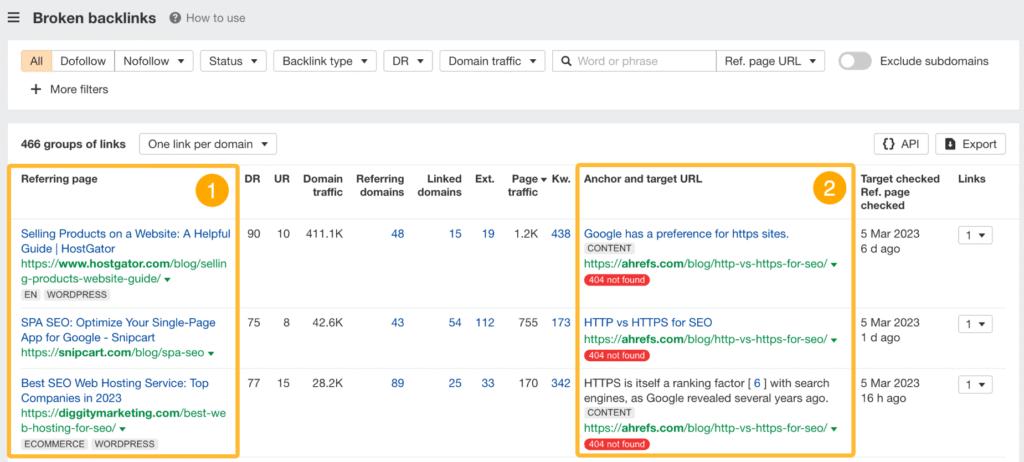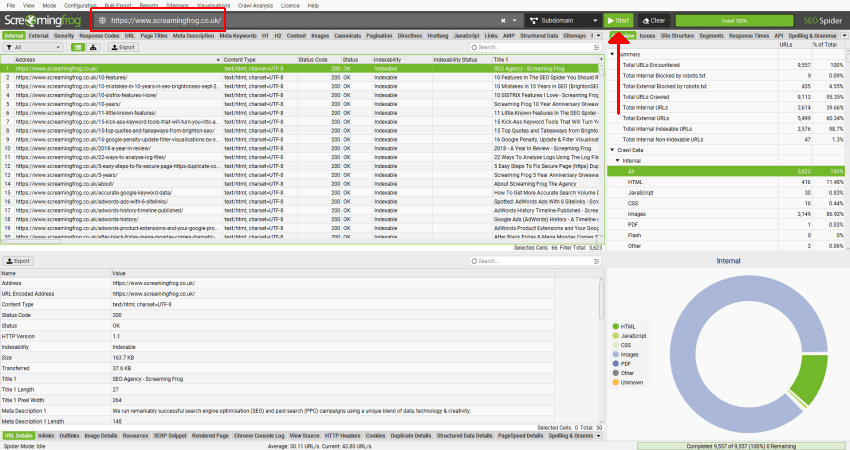Every link pointing to your site tells Google something about your content’s value. It’s a trust signal, a vote of confidence, and a key part of how pages earn authority. But that power vanishes when a backlink points to a page that no longer exists.
Broken backlinks mean more than just a 404 error. They translate to lost authority, wasted referral traffic, and a slow drip of diminished rankings. If too many go unfixed, your SEO performance can take a noticeable hit.
The upside? You can recover that link equity. You just need the right process and tools to catch broken backlinks early, fix them strategically, and keep your rankings stable.
This guide breaks it all down—how to find broken backlinks, how to fix them (fast), and how to keep your site’s authority growing instead of leaking away.
What Are Broken Backlinks? (And Why They Matter)
A broken backlink is exactly what it sounds like: another site links to a page on yours, but that page no longer exists or leads to an error. The most common culprit is the dreaded 404.
So why does this happen? There are a few likely reasons:
- You deleted or renamed a page
- You restructured your URLs during a redesign
- You migrated your site without preserving link paths
- The linked content was outdated and removed
And while the error may seem small, the SEO effects stack up fast.
Broken backlinks cut off the flow of link equity (often called “link juice”). That means Google sees fewer votes of confidence pointing toward your site, which can slowly degrade your authority. If the broken link pointed to a page that used to rank well, you may notice drops in traffic, slower indexing, or lower keyword rankings.
There’s also a trust factor. If users click on a link and hit a dead page, they’re less likely to return… and the linking site may remove the link altogether.
Here’s what you need to know: every broken backlink is a missed opportunity. Fixing them gives you a way to reclaim lost value without needing to build brand-new links from scratch.
How to Identify Broken Backlinks (Tools + Methods)
You can’t fix what you don’t know is broken. So the first step is locating your broken backlinks—and there are a few trusted tools that make this job much easier.

Start with the Coverage and Links reports:
- In Coverage, look for pages returning “404” errors.
- In Links, check for top linked pages and sort them by internal and external backlinks.
Cross-reference both reports to spot external links pointing to dead pages. While GSC won’t catch every broken backlink, it’s a free and reliable place to begin.

2. Ahrefs
Ahrefs’ Broken Backlinks tool is one of the best out there:
- Go to Site Explorer > Backlinks > Broken
- Filter by “404 not found”
- Sort by DR (Domain Rating), traffic, or link type
This gives you a clear list of referring domains, target pages, and anchor text. You can export the data and start building your fix list.

3. Semrush
If you’re using Semrush, the Backlink Audit tool offers similar insights:
- Run a full audit and look for Lost Backlinks
- Use the Target URL error column to identify pages returning 404s
- Filter by link type, domain strength, and referring source
Semrush is especially helpful if you’re already tracking competitors—it lets you benchmark your backlink health against others in your niche.

4. Screaming Frog + Backlink Imports
Screaming Frog can crawl your site and report broken internal and external links. To find external broken backlinks, you can:
- Export your backlink profile from Ahrefs or Semrush
- Import those URLs into Screaming Frog as a list
- Crawl the list to identify broken destination URLs
It’s a bit more manual, but ideal if you’re doing a deep technical audit.
How Often Should You Run These Checks?
- At least once a month for active sites
- Immediately after any redesign, site migration, or large content update
- After content pruning or URL restructuring
Build a spreadsheet to log broken links, referring URLs, the fix method, and current status. This keeps things organized and makes progress easier to track.
Fix Option 1: Redirect the Broken URL (301s Done Right)
The fastest way to fix a broken backlink? Redirect it.
A 301 redirect tells search engines the page has permanently moved. It also passes most of the original link equity to the new page—as long as the redirect makes sense.
When should you redirect?
- You deleted a page but have a similar one live
- You changed the URL during a rebrand or migration
- The content is gone, but the topic still exists elsewhere on your site
Avoid redirect mistakes:
- Never send every broken link to your homepage (Google hates this)
- Don’t create redirect chains (one URL redirecting to another, and then another)
- Watch out for redirect loops—they’ll tank crawl efficiency and confuse users
- WordPress: Use a plugin like Redirection or Rank Math
- Shopify: Go to Online Store > Navigation > URL Redirects
- .htaccess (Apache servers): Add Redirect 301 /old-page /new-page
Pro tip: always redirect to the most relevant, high-quality page—not just a catch-all. You’ll preserve more equity and improve the user experience at the same time.
Fix Option 2: Recreate the Missing Page (Content Recovery)
Some links are too valuable to lose—and the best way to keep them might be to bring the old page back to life.
Start by checking what the original content looked like using the Wayback Machine or Google Cache. Look for clues about the topic, structure, and intent of the page.
Is the topic still relevant? If so:
- Rebuild the page using updated information
- Refresh the design and structure to match current standards
- Add internal links to support the page and pass equity through your site
- Include a strong CTA to turn incoming referral traffic into leads
Treat this as part of your ongoing content strategy. Recovered pages can perform just as well (sometimes better) than the originals, especially if they’re updated for today’s search intent.
Fix Option 3: Reach Out and Reclaim the Link (Manual Outreach)
Sometimes a redirect doesn’t make sense. Maybe the content isn’t worth recreating, or the old URL had a misspelling. In these cases, outreach is your next best move.
Here’s what to do:
- Identify the linking page (Ahrefs and Semrush both show this)
- Find contact info for the site owner, editor, or content team
- Write a short, professional message explaining the issue
- Suggest a new page or updated link they can replace it with
Email Template:
Hi [First Name],
I noticed that one of your articles is linking to a page on our site that now returns a 404.
Here’s the page you’re linking from: [URL]
And here’s the broken link: [Broken URL]
We’ve recently updated our content and created a new page that’s even more helpful: [New URL]
Would you mind updating the link? It’ll improve the experience for your readers and keep the resource live.
Thanks so much!
[Your Name]
Personalize your message where possible. Reference their article, compliment their content, or offer value in return. Outreach success often hinges on that human touch.
Keep track of who you contacted, when, and whether they responded. Follow up once—but don’t spam.
Prioritize the Most Valuable Links First
Not every broken backlink is worth your time. Focus your energy where it counts.
Here’s how to evaluate link value:
- Domain Authority: High-authority sites pass more trust
- Relevance: Industry blogs or niche-specific content is gold
- Referral Traffic: Use analytics to see which links sent actual visits
- .edu / .gov Links: Rare, trusted, and worth saving
Low-quality, spammy, or nofollowed links? Unless they drive traffic, they can wait. Create a scoring system—maybe based on DA, traffic, and content relevance—to prioritize which links get fixed first.
It’s a smarter way to work, especially if your site has hundreds (or thousands) of backlinks.
How to Prevent Broken Backlinks Going Forward
Fixing links is great—but preventing them saves you time and rankings.
Here’s what you can do:
- Stick to a consistent URL structure during site updates
- Use 301 redirects for every content move or rename
- Don’t delete high-performing content—refresh and repurpose instead
- Set up link monitoring using Ahrefs Alerts or Screaming Frog’s scheduled crawls
- Run quarterly backlink audits, or anytime you do a major redesign, content overhaul, or CMS migration
A little prevention keeps your link equity safe and your rankings steady.
Reclaim Link Equity Before It Slips Away
Broken backlinks aren’t just technical issues—they’re missed chances to reclaim what you’ve already earned. Every 404 link could be pointing valuable authority and traffic straight into a black hole.
The good news? You’ve got options. Redirects, rebuilds, and outreach all offer ways to repair those gaps and keep your SEO strategy strong.
Stay proactive, stay organized, and make backlink maintenance part of your monthly checklist. Your rankings—and your bottom line—will thank you.
Ready to Elevate Your Brand?
It’s time to stop guessing and start growing. At Content-Author.com, we help brands like yours reach new heights with strategy-driven SEO, PR, and content marketing that actually converts. Whether you need authoritative backlinks, powerful editorial placements, or optimized web content that drives traffic and sales — our team delivers results that speak for themselves.
Let’s turn your goals into measurable growth.
👉 Book Your Free Strategy Call and see how fast we can move the needle together.
